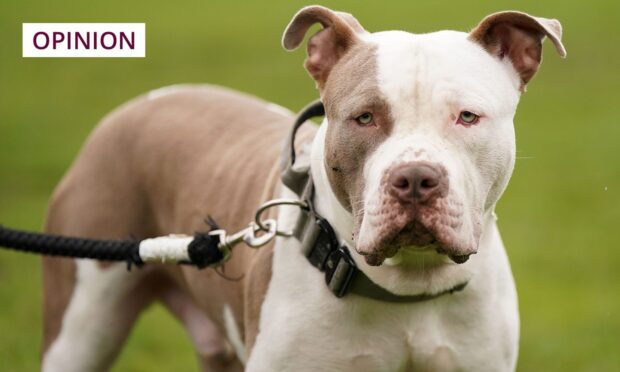Are dogs born dangerous?
To me, that’s the real question at the heart of the debate over XL Bullies, and whether or not Scotland should follow the lead of our southern neighbours and ban the breed.
There’s already a ban on breeding the giant dogs across England and Wales, and any XL Bullies out in public must be leashed and muzzled at all times.
But come February 1, anyone down south who has one of these hulking, slobbering, loving beasts as a pet – or any rescue centres sheltering them – will be forced to euthanise them, unless they can acquire an exemption certificate.
And if you’re wondering how much the life of some people’s beloved four-legged friends is worth to the UK Government, it’s a tidy £92.40 to apply for one.
After that, any unexempted XL Bully in the country will be destroyed. Except in Scotland.
So it’s easy to see why XL Bully owners and dog lovers are flocking to the north to save their pets or, in cases like campaigner Kerryanne Shaw’s, give sanctuary in the Dundee area to those dogs who would otherwise be killed despite having done nothing wrong.

Euthanising a whole breed of healthy, innocent dogs to order is, from where I’m standing, nothing other than mass murder. And it’s shameful.
So I’m glad to live in a nation which hasn’t taken that extreme measure.
But the fear that people have of XL Bullies is something I understand, even as a dog-lover and former owner of another ‘danger’ dog breed.
My ‘danger’ dog was no danger at all
My German Shepherd Floyd was vilified for his breed all his life; yet the truth is, the biggest danger I faced while walking him was the vitriol spouted by those too ignorant to educate themselves on the difference between nature and nurture.
Shepherd dogs are naturally wilful, and if not given a firm hand, they can turn territorial and – yes – dangerous.
But so can chihuahuas. And Lhasa Apsos. I’ve been bitten by more than one Jack Russell terrier in my time, but no one’s trying to ban those yappy wee grumps.
And more often than not, so-called ‘dangerous’ dogs like German Shepherds, Rottweilers and Staffies are sweet, gentle natured and perfectly safe.
The difference, of course, is that if a big dog bites, the damage is serious; and in the case of the XL Bully, it can be fatal.
So I completely understand people’s hesitation around larger dog breeds, especially since lockdown has seen a spike in poorly trained, unsocialised pooches.
But in all of these cases, the danger is the owner, not the breed. So I’m inclined to agree with the SSPCA’s stance that banning by breed is ineffective in reducing dog attacks.
After all, a feckless owner will simply move on to another, more accessible breed of dog, and create a nuisance of that too.
It’s already happening, with searches for Rottweilers and Cane Corsos – both huge, intimidating and perfectly legal breeds – up by 35% and 36% respectively since breeding XL Bullies was banned on Hogmanay.
How long before they are the ‘leading’ breeds responsible for dog attacks across the nation?
Dangers of banning XL Bullies
It seems to me that ‘dangerous’ dogs are defined by the reputations of those who use trendy breeds as status symbols or sources of income (XL Bully pups can fetch £1,000 per dog easily).
Banning them outright will only drive their trade into criminal markets. Common sense will tell you that anything the government ‘bans’ doesn’t leave society.
Look at the drugs on the streets of Dundee, or the human trafficking taking place across rural Scotland, and it’s easy to see that a blanket ban is just a way for authorities to consider a persisting problem cleared off their plates.
You can’t regulate what you refuse to acknowledge.
However, it’s clear that XL Bullies are about to pose a problem for Scotland. Whether they were born dangerous or not, an influx of surrendered, confused, puma-sized dogs is not safe to have on our streets.
The breed is undeniably powerful, and with evidence that repeated inbreeding caused by poor regulation can cause a prevalence of individuals with aggressive natures, I can concede that these amazing dogs should perhaps, at this point, be allowed to die out naturally in the UK, as much for the animals’ sakes as for society’s.
But that doesn’t mean we need to kill them. Most dogs are good dogs, and good dogs deserve to live out their days in peace.
XL Bullies are not bad dogs
Implementing a breeding ban, tightening up regulations around ownership (including mandatory neutering) and adopting the public muzzling policy should be the way forward for Scotland’s XL Bully population.
Responsible pet owners who want to care for their furry family members until the end of their natural lifespan will adapt. Love adapts.
Within about 13 years, a breeding ban would see the breed gradually decline into oblivion.
And who knows? Perhaps the bloodlines could be reintroduced more carefully in the future, with a focus on breeding for good temperament.
Either way, Scotland is right not to blanket euthanise these unfortunate animals on February 1.
Careless humans bred these so-called ‘monsters’.
In trying to right that wrong, we must be careful not to become monsters ourselves.














Conversation